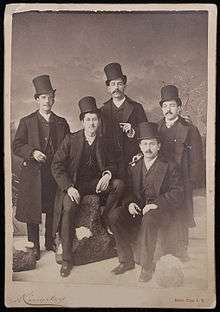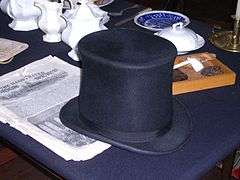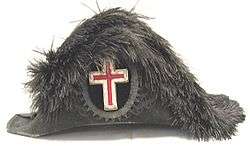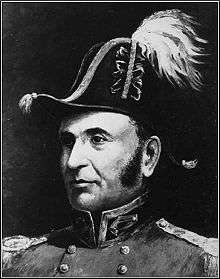Beaver hat





A beaver hat is a hat made from felted beaver fur. They were fashionable across much of Europe during the period 1550–1850 because the soft yet resilient material could be easily combed to make a variety of hat shapes (including the familiar top hat).[1] Smaller hats made of beaver were sometimes called beaverkins,[2] as in Thomas Carlyle's description of his wife as a child.[3]
The demand for beaver pelts in Europe ultimately drove the animal to near-extinction. Its popularity contributed to the dwindling of the population of the animal in the New World and fuelled colonial expansion as more people sought the fortunes of the trade.
In 1624 (the year New York was first settled) Dutch settlers were recorded having shipped 1500 beaver and 500 otter skins to Europe.
Used winter coats worn by Native Americans were actually a prized commodity for hat making because their wear helped prepare the skins; separating out the coarser hairs from the pelts.
The busy trade in beaver pelts was a fundamental factor in the exploration and early settlement of Canada. The Hudson's Bay Company, which was founded in 1670 and is still in existence, made its fortune through this trade. For its role in Canada's early economic development, the beaver has been honoured with a depiction on the Nickel (Canadian coin).
To make felt, the underhairs were shaved from the beaver pelt and mixed with a vibrating hatter's bow. The matted fabric was pummeled and boiled repeatedly, resulting in a shrunken and thickened felt. Filled over a hat-form block, the felt was pressed and steamed into shape. The hat maker then brushed the outside surface to a sheen.[4] Beaver hats were made in various styles as a matter of civil status: the Wellington (1820–40), the Paris beau (1815), the D'Orsay (1820), the Regent (1825) and the clerical (18th century). In addition, beaver hats were made in various styles as a matter of military status: the continental cocked hat (1776), Navy cocked hat (19th century), and the Army shako (1837).[5]
The popularity of the beaver hat declined in the early/mid-19th century as silk hats became more fashionable.
References
- ↑ Wallace-Wells, D. "Puritan Inc." The New Republic, 2010.
- ↑ Picken, Mary Brooks (1999). A dictionary of costume and fashion : historic and modern : with over 950 illustrations. Courier Dover Publications. p. 160. ISBN 9780486141602.
- ↑ Carlyle, Thomas (2012) [1881]. Froude, James Anthony, ed. Reminscences. Cambridge University Press. ISBN 9781108044790.
...dainty little cap, perhaps little beaverkin (with flap turned up)...
- ↑ Walter Brigham, Baltimore Hats, http://www.gutenberg.org/files/39780/39780-h/39780-h.htm#OLD_METHODS
- ↑ Charlotte Gray, The Museum Called Canada: 25 Rooms of Wonder, Random House, 2004
External links
| Wikimedia Commons has media related to Beaver hat. |
